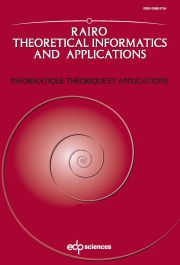Article contents
On the Analysis of Petri Netsand their Synthesis fromProcess Languages
Published online by Cambridge University Press: 15 November 2003
Abstract
Processes in Place/Transition (P/T) nets are definedinductively by a peculiar numbering of place occurrences. Alongwith an associative sequential composition called catenation and a neutralprocess, a monoid of processes is obtained. The power algebra of this monoidcontains all process languages with appropriate operations on them. Hencethe problems of analysis and synthesis, analogous to those in the formallanguages and automata theory, arise. Here, the analysis problem is: for agiven P/T net with an initial marking find the set of all processes the netmay evoke. The synthesis problem is: given a process language Ldecide if there exists a marked net whose evolutions (represented byprocesses) are collected in L and, in the positive case, find suchnet and its initial marking. The problems are posed and given a generalsolution.
Information
- Type
- Research Article
- Information
- Copyright
- © EDP Sciences, 2003
References
- 1
- Cited by

